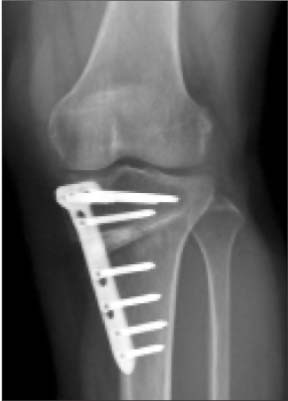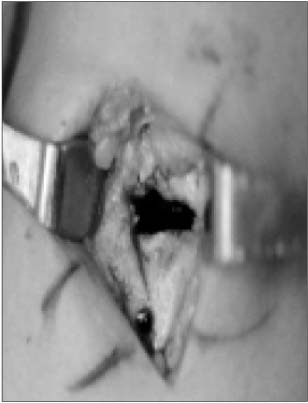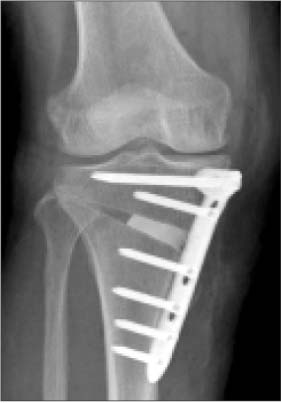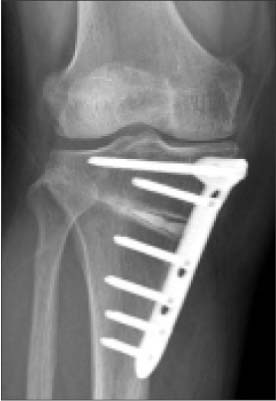J Korean Orthop Assoc.
2015 Oct;50(5):424-428. 10.4055/jkoa.2015.50.5.424.
Interference of Union after the Use of Beta-Tricalcium Phosphate Block in High Tibial Osteotomy
- Affiliations
-
- 1Department of Orthopedic Surgery, Bumin General Hospital, Busan, Korea. osjjs49@gmail.com
- KMID: 2185107
- DOI: http://doi.org/10.4055/jkoa.2015.50.5.424
Abstract
- High tibial osteotomy (HTO) is a commonly used treatment for genu varum and medial compartment osteoarthritis. Recently open wedge HTO has been the preferred method due to its facilitated technique, fewer neurovascular and joint injuries, etc. In open wedge HTO materials such as autogenous, allogenous bone graft and tricalcium phosphate (TCP) are used to help with bone union and have a role in filling in the empty space. However the authors of this study report on two cases of nonunion 1 year after HTO using TCP block.
Figure
Reference
-
1. Tanaka T, Kumagae Y, Chazono M, Kitasato S, Kakuta A, Marumo K. A novel evaluation system to monitor bone formation and β-tricalcium phosphate resorption in opening wedge high tibial osteotomy. Knee Surg Sports Traumatol Arthrosc. 2015; 23:2007–2011.
Article2. Poignard A, Flouzat Lachaniette CH, Amzallag J, Hernigou P. Revisiting high tibial osteotomy: fifty years of experience with the opening-wedge technique. J Bone Joint Surg Am. 2010; 92:Suppl 2. 187–195.
Article3. Niemeyer P, Koestler W, Kaehny C, et al. Two-year results of open-wedge high tibial osteotomy with fixation by medial plate fixator for medial compartment arthritis with varus malalignment of the knee. Arthroscopy. 2008; 24:796–804.
Article4. Gouin F, Yaouanc F, Waast D, Melchior B, Delecrin J, Passuti N. Open wedge high tibial osteotomies: calcium-phosphate ceramic spacer versus autologous bonegraft. Orthop Traumatol Surg Res. 2010; 96:637–645.
Article5. Floerkemeier S, Staubli AE, Schroeter S, Goldhahn S, Lobenhoffer P. Outcome after high tibial open-wedge osteotomy: a retrospective evaluation of 533 patients. Knee Surg Sports Traumatol Arthrosc. 2013; 21:170–180.
Article6. Onodera J, Kondo E, Omizu N, Ueda D, Yagi T, Yasuda K. Beta-tricalcium phosphate shows superior absorption rate and osteoconductivity compared to hydroxyapatite in open-wedge high tibial osteotomy. Knee Surg Sports Traumatol Arthrosc. 2014; 22:2763–2770.
Article7. Lee YS, Moon GH. Comparative analysis of osteotomy accuracy between the conventional and devised technique using a protective cutting system in medial open-wedge high tibial osteotomy. J Orthop Sci. 2015; 20:129–136.
Article8. van Houten AH, Heesterbeek PJ, van Heerwaarden RJ, van Tienen TG, Wymenga AB. Medial open wedge high tibial osteotomy: can delayed or nonunion be predicted? Clin Orthop Relat Res. 2014; 472:1217–1223.
Article9. Meidinger G, Imhoff AB, Paul J, Kirchhoff C, Sauerschnig M, Hinterwimmer S. May smokers and overweight patients be treated with a medial open-wedge HTO? Risk factors for non-union. Knee Surg Sports Traumatol Arthrosc. 2011; 19:333–339.
Article10. Saragaglia D, Blaysat M, Inman D, Mercier N. Outcome of opening wedge high tibial osteotomy augmented with a Biosorb® wedge and fixed with a plate and screws in 124 patients with a mean of ten years follow-up. Int Orthop. 2011; 35:1151–1156.
Article
- Full Text Links
- Actions
-
Cited
- CITED
-
- Close
- Share
- Similar articles
-
- Analysis of the Factors Affecting Bone Union after Open-Wedge High Tibial Osteotomy and Graft Material for Lateral Cortex Fractures
- Union Rates of Local Autobone and beta-Tricalcium Phosphate Mixed Graft in Lumbar Posterolateral Fusion
- Treatment of Infected Non-union in the Knee with High Tibial Osteotomy State: A Case Report
- High Tibial Osteotomy With Fibular Shaft Osteotomy
- The Effect of beta-Tricalcium Phosphate and Deproteinized Bovine Bone on Bone Formation in the Defects of Rat Calvaria








